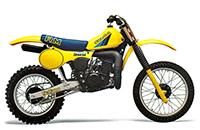In 1983 Kawasaki released the first KX500. Right from the start, it was destined to become a legend
Kawasaki would outlast all the others that followed, officially finishing up the 500cc two-stroke class in 2004. For over 20 years, it was generally accepted that if any bike made more power than a Kawasaki KX500, it was impractical. Today’s 450 four-strokes make about the same peak power as the first KX500 of 30 years ago.
But what made the 500 so formidable was the narrow powerband and harsh delivery. Unfortunately the market gradually moved away from the KX500 and the other 500s. When it was dropped from the Kawasaki line, it had been unchanged for more than 10 years, and its sales numbers were low. If the KX had moved with the times, it might have lasted longer.
At birth, the KX500 was fast, but had a poorly designed combustion chamber that resulted in self-destructive tendencies. The compression had to be lowered, and that killed any performance edge it might have had.
Two years later the first of the great KX500s was produced. It got a new motor with liquid-cooling and it was, for the first time in Kawasaki’s history, the best bike in its class. The next year, Kawasaki gave the KX a feature that no other 500cc two-stroke had ever seen, a exhaust power valve. After 1987, updates came yearly as Kawasaki and Honda locked horns in a battle for dominance of the class.
The Kawasaki got a new frame and the side-access airbox was abandoned. The rear suspension was reconfigured, losing the big Unitrak rocker arm on top. In 1988 the KX500 got its last big redesign. It got minor mechanical changes and cosmetic updates afterward, but the most significant event was the arrival of the upside-down fork in 1990. Two years later, the ignition and crank were changed.
By the early ֹ’90s, Honda had given up the horsepower chase, leaving the KX unchallenged as the most powerful dirt bike made. Kawasaki KX500s are readily available on the used bike market. With a bike that was unchanged for this long, it’s all about condition, not vintage.
Few of them were raced, although many were mistreated. Parts are still available for anything that was manufactured after 1990. One of the great things about used KX500s is that they are fairly indestructible.
They could swallow dirt and keep running. The electrofusion cylinder couldn’t be bored, but the coating would last a long time. The most common modification was frame reinforcement. The KX chassis wasn’t as indestructible as the engine. The pipe mount and footpeg mounts always got beefed up or re-welded. It’s easy to tell a KX500 that hasn’t been looked after.
If the rear shock seal is leaking, the fork seals are leaking, the rear linkages are seized, the chain, sprockets and brakes are totally flogged out or the engine is just hard to start and won’t run well, then the bike hasn’t been maintained and it is best to steer clear of. If you get one in perfect condition then it is certainly a bike worth hanging onto.
PRICE GUIDE:
$1800 – $3800 (Glass’ Guide, June 2015)
FEATURES:
Brakes
The later models have hydraulic front brakes with a single disc and a twin-piston floating caliper and the rear are hydraulic with a single disc and a single-piston floating caliper.
Frame
The frame is a semi double-cradle unit made of high-tensile steel. The frames were known to fracturing around the footpeg brackets, which required re-welding and strengthening.
Weight
The KX500 had a dry weight of about 100kg.
Engine
The last of the KX 500s had a bore and stroke of 86mm x 86mm and was fed by a Keihin PWK 39 carburettor.
Suspension
The suspension was converted in 1990 to 46mm USD cartridge forks with 310mm of travel.
MARKET EQUIVALENTS:

1982-88 Yamaha YZ490

1984-2003 Honda CR500R

1983-86 Suzuki RM500

1985-95 KTM 500MX
To receive the latest news, reviews and video highlights from the world of dirt bikes, sign up to our weekly newsletter here.
